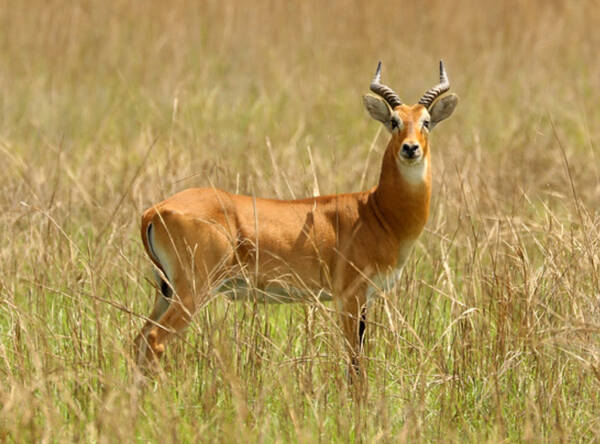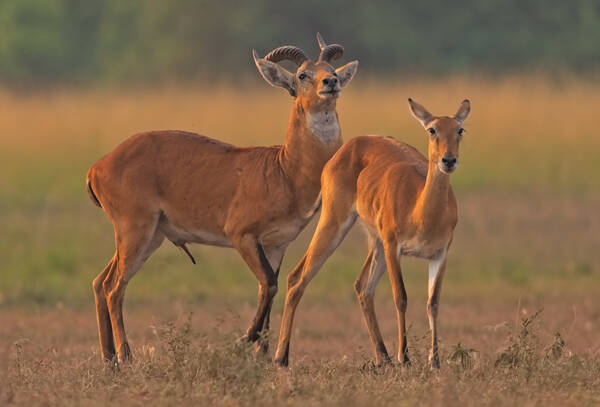Kobus kob
IUCN
LCBasic Information
Scientific classification
- name:Kobus kob
- Scientific Name:Kobus kob
- Outline:Ungulata
- Family:Artiodactyla Bovidae Koi
Vital signs
- length:125-180cm
- Weight:50-120kg
- lifetime:About 10 years
Feature
White circles around the eyes and black lines on the legs
Distribution and Habitat
Origin: Benin, Burkina Faso, Cameroon, Central African Republic, Chad, Democratic Republic of Congo, Honduras, Ethiopia, Ghana, Guinea, Guinea-Bissau, Mali, Niger, Nigeria, Senegal, South Sudan, Togo and Uganda.
Possibly extinct: Mauritania; extinct: Burundi, Gambia, Kenya, Sierra Leone and Tanzania.
The habitat of the red waterbuck is mainly grasslands and floodplains along rivers, grasslands, seasonal floodplains in tropical savanna woodlands and waterside grasslands.
Appearance
The Red Waterbuck measures 125-180 cm at the shoulder, 70-105 cm at the withers, and has a tail length of 20-40 cm. It weighs 50-120 kg. The smooth, glossy coat varies from golden brown to chestnut, with a bright white underparts. Males darken with age, becoming a dark mahogany color in the White-eared Cob (K. k. leucotis). White facial markings include the conspicuous eye ring, the inside of the ears, and the throat bib. The outside of the forelegs has a distinctive vertical black stripe that runs the length, while the inside is white. The bushy tail is white underneath and ends in black. Only males have "S" shaped horns, which are 40-69 cm long and have transverse corrugations, and they are curved and upturned at the tip. There are several subspecies, including the nominate subspecies, distinguished primarily by variations in the darkness of the coat.
Details
Kobus kob (Kob in English, Grasantilope in German, Cobe de Buffon in French) has 8 subspecies.

Kobus kob may migrate long distances and graze along rivers during migration. One group in southeastern Sudan traveled 150-200 km during the dry season. During these migrations, populations may reach great densities.
The red waterbuck is mainly active during the day, being most active in the early morning and evening. They form mixed groups of both sexes (some individuals older than 8 months), and the size of the group can vary greatly over a short period of time. These groups consist of females and single males and range from 5 to 40 animals. Females occupy large, overlapping home ranges, which vary in size depending on habitat and population density, which changes and moves with food availability. Adult males are territorial, and males are more restricted in their movements, usually remaining close to lek areas. Groups of non-breeding males may also form. Population density varies greatly. In suitable habitats, 8-124 individuals per square kilometer have been reported. This variation in density affects male mating strategies. Males may move in groups, hold a single territory, or defend a mating ground territory. Higher populations favor mating. The Honduran waterbuck has a lower population density, so there are no mating grounds.
The territories defended by waterbucks are at two extremes, either a few relatively large territories or a group of extremely small territories. These compact groups, called mating grounds, are usually 200 meters in diameter, with 12-15 (rarely more than 200) approximately circular individual territories, 15-30 meters in diameter. These resident males do not mark their territories, but patrol their boundaries, often whistling loudly. Males occupy territories for periods ranging from a few days to several months. Depending on the habitat, population densities range from 8-124 animals per square kilometer. In southeastern Sudan, during the dry season from November to April, large numbers of livestock gather on waterways, when densities often exceed 1,000 per square kilometer. The red waterbuck is a herbivore that feeds on grasses and reeds.

The red waterbuck typically has a mating ground system, in which males protect small territories that gather at traditional mating grounds. Females go to these mating grounds only to breed, and males do not provide care for their young. This mating system probably evolved because males could not defend widely distributed food resources or dynamic and temporary herds of females. Within a mating arena, 20-200 males defend territories with a diameter of 15-200 meters. Males have smaller territories with more intense competition, and are located in the center of the arena, where the most mating occurs. These territories remain popular among females despite the rapid turnover of males. In areas with lower population density of the species, males are farther apart and occupy territories for longer periods of time. Each mating arena is associated with a group of females consisting of about 100 individuals. Females begin mating at the age of one year, but males usually have to wait a few more years. More females are associated with larger mating arenas, probably because females stay longer in the arena when more males and other females are present. The gestation period of the red waterbuck is about 9 months, and one offspring is born per litter. The season for calving may vary from location to location, but the red waterbuck population in Kob, Uganda, gives birth at the end of the rainy season in November-December.
The number of red waterbuck was estimated at 95,000 in 1999, but the population has declined significantly since then. As of 2007, there are estimated to be more than 753,572 in South Sudan. In 1999, there were an estimated 100,000 in Uganda, and as of 2013, the number in protected areas may have stabilized, but no updated estimates are available. Overall, the number of red waterbuck is declining throughout its range. In areas of favorable habitat with good conservation practices, red waterbuck can reach high densities, ranging from 15-40 per square kilometer (2013); however, in areas of high hunting pressure, densities decline to less than 1 per square kilometer (1998). The highest densities of red waterbuck have been reported around drinking sites during the dry season, at 1,000 per square kilometer (1987).
Listed in the IUCN Red List of Threatened Species in 2016 ver3.1 - Least Concern (LC).
Protect wild animals and eliminate game.
Maintaining ecological balance is everyone's responsibility!








